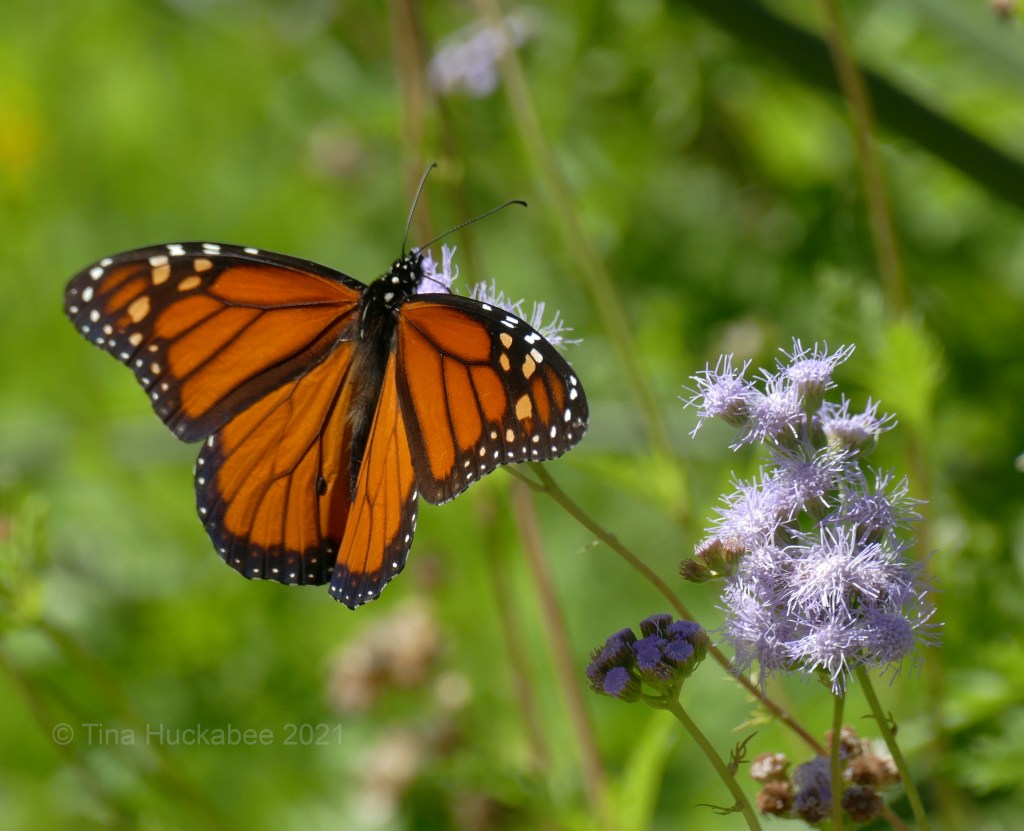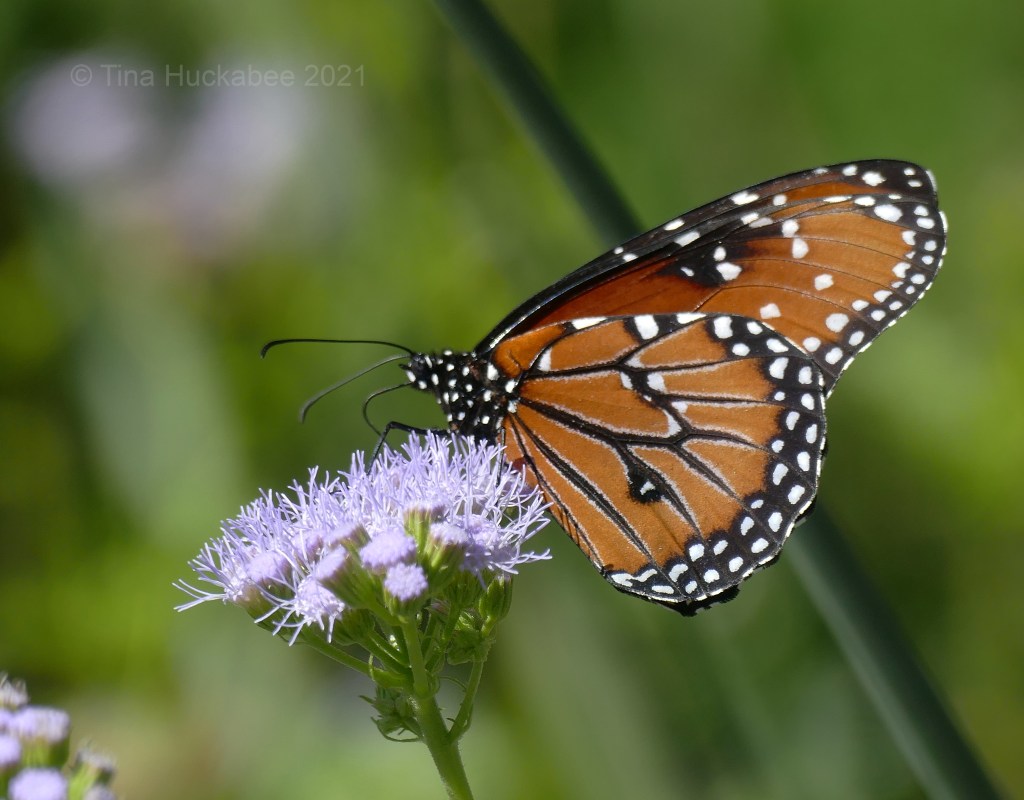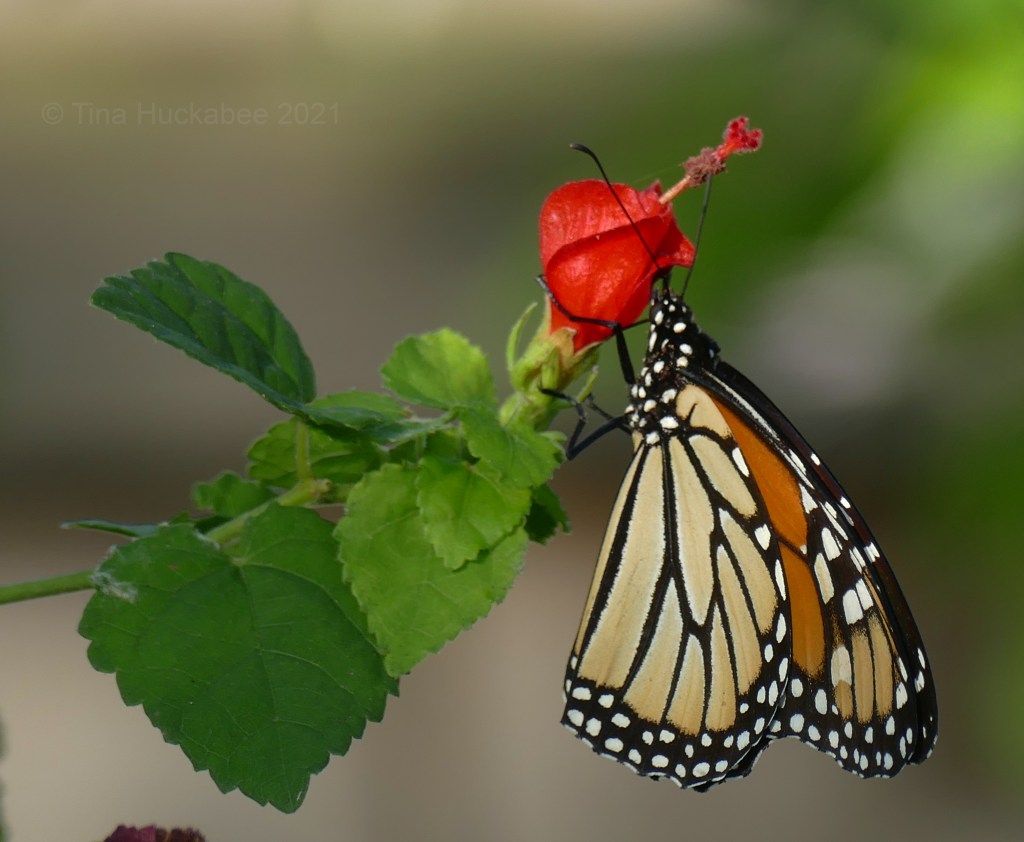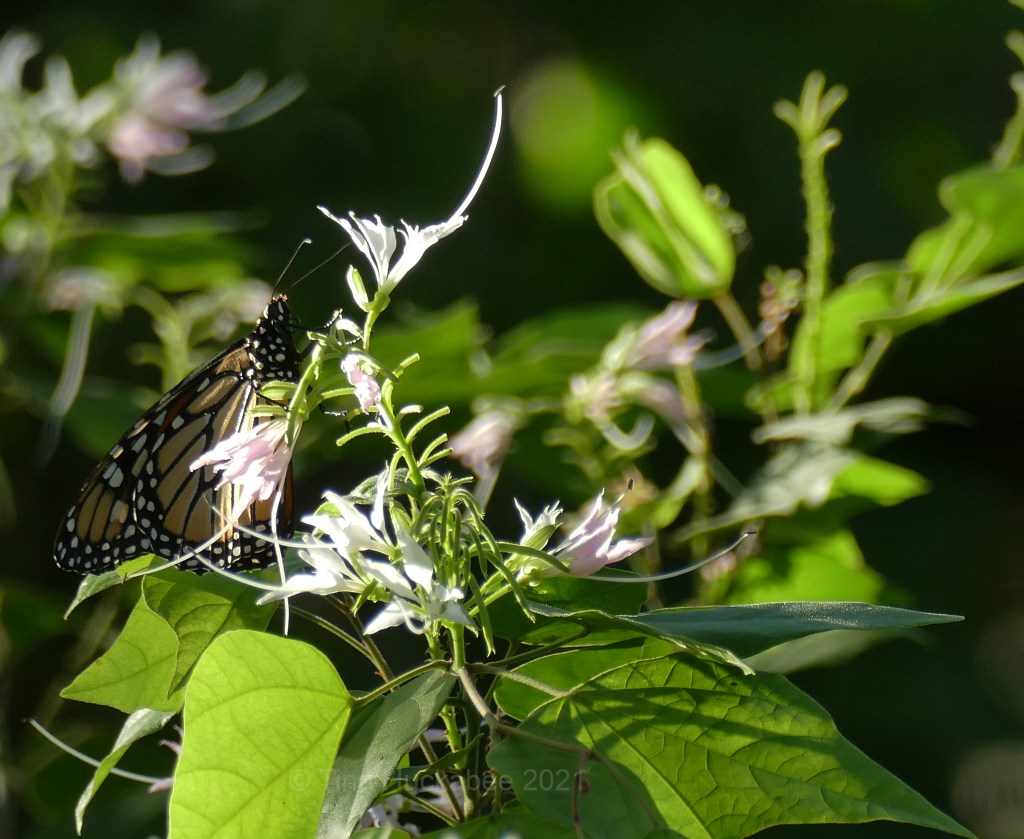A while back I’d read that this year was good for the Monarch Butterfly, Danaus plexippus. From Canada, through the mid-west states of the United States, and now in Texas, Monarchs are on the move in healthier numbers than in recent years. I saw my first autumn Monarch back in August, earlier than normal, but I never complain when I see a butterfly, especially a Monarch. Throughout September, individuals wafted through my garden, drifting up and down in gentle butterfly fashion, alighting to nectar on whatever flower caught their fancy.
In the past week, the amount Monarchs visiting my garden has exploded to numbers I haven’t seen in years–if ever.

On blooming, mostly native Texas perennials, there are 10-20 fluttering beauties sipping the good stuff from the flowers’ offerings.

It’s been many years since I’ve seen this number of Monarchs and I’d forgotten the soft sound of many butterfly wings as they whoosh from their feeding perches: joyful for the gardener and full of promise and life for the insect.

The Monarchs are nectaring on a variety of flowers, but wings-down their favorite is Frostweed, Verbesina virginica. I’m grateful that I grow a number of these tough native plants which produce blooms that Monarchs and many other pollinators love.

Monarchs are also fond of Gregg’s Mistflower, Conoclinium greggii. This charmingly fuzzy ground cover perennial blooms throughout summer, but the height of its blooming season is September through November–just in time for the Monarchs.



Interestingly, most of my close up photos are of male Monarchs. The two black dots on the hindwings indicate a male. Also, the black segment veins on their wings are thinner than those of females.

It’s not only the Monarchs that are gracing the garden, but scads of other pollinators are out in full force like this cousin-to-the-monarch, the Queen Butterfly, Danaus gilippus.

Monarchs and Queens resemble one another in their similar coloring, adorned with black veins and white dots, but Monarchs are larger than Queens. Unlike Monarchs, which we Texans only see during spring and autumn migration, Queens are familiar in Texas gardens throughout the year because they don’t migrate. It’s common that Queens are mistaken for Monarchs, but check out this great tutorial on how to tell the difference between the two.
Monarchs are fueling for their continuing migration to Mexico for winter. Other flowers they nectar from include this native Turk’s Cap, Malvaviscus arboreus var. drummondii,

…and the lush blooms of the Mexican Orchid tree, Bauhinia mexicana.


To witness the results of a successful year for this beleaguered and endangered creature is heartwarming, but it also validates my decision years ago to use mostly native plants in my garden and to always plant for the benefit of pollinators and other wildlife.
A garden is at its best when supporting life.

Tina – what a wonderful post! Seeing all those butterflies made me so very happy! So glad to hear that they had a good year! Frame-worthy photos, too.
LikeLike
Thanks, Anna. It’s been a real joy to watch the butterflies, especially this week. I hope they have a safe flight to Mexico.
LikeLiked by 1 person
I do to!
LikeLiked by 1 person
That must be amazing to have in your garden!
LikeLike
It’s been wonderful, Brian!
LikeLike
How wonderful that you experience the migration in your yard and that it is such a large one this year. All those efforts by butterfly lovers must be paying off. Here in the Northeast we saw quite a number in our yard on the milkweed we encourage to attract them and feed their larvae. It is heartening to see the numbers rebound. It must be wonderful to see so many at your flowers.
LikeLike
It’s been so, so wonderful! Glad you have milkweed in your garden, maybe some of the babies you nurtured with your milkweed are the adults in my garden! Just recently, I scored 4 pots of one of the native milkweed to this area. I was so happy as it tends to be hard to find. I’ll plant it in my front garden when our poor, mostly dead Arizona ash tree is removed next month.
LikeLiked by 1 person
I am in awe. Nothing like this in my NW Florida garden. Ever.
LikeLike
It truly has been awesome! It’s a rarity for me, too, but I’m so grateful.
LikeLike
Your “wings down” is an apt and clever way to put it. It’s good that you’ve seen so many monarch wings this season, whether up or down. You’ve got some excellent closeups here, which do as good a job of highlighting the native wildflowers as they do portraying the butterflies.
LikeLike
Thanks, Steve. Except for the Mexican orchid tree, the Monarch go only to the native plants. So glad that I have them in abundance.
LikeLike
That is great news. I have had very few on this side of the state, so they all must be heading your way. Do you follow “Monarch Watch”? They have a website and try to keep track of migration and numbers.
LikeLike
I think they tend to funnel through Central Texas and since it’s such a banner year, there are just so many more of them. I do follow Monarch Watch–they do such a good job!
LikeLiked by 1 person
Lovely.
LikeLike
Yes it is!
LikeLike
So excited by your many garden visitors Tina. The photographs are just amazing.
LikeLike
Thanks–it’s been a wonderful week of watching!
LikeLike
Amen to natives, and so heartening to have confirmation of large numbers of monarchs passing through your area. I guess the weather has been favorable and perhaps enough folks are now planting enough milkweeds to sustain the larval stage. I, too, garden for wild life, it is so rewarding!
LikeLike
I think all along their migratory paths, there’s more native milkweed being planted and it was a good year. Fingers-crossed that they all make it to their Mexican mountain winter home and don’t suffer any ‘too-early’ or ‘too-late’ hard freezes. Poor things, so much is against them.
Wildlife gardening is very rewarding, I agree!
LikeLiked by 1 person
Tina how wonderful that this year there are so many Monarchs in your garden on native plants !!! Tina the photos are magnificent, divine. Tina has made a garden for wildlife and she has more than rewarded you. What a fantastic experience to see your garden with such a high number of Monarch Butterflies and you among them !!! The Queen Butterfly is very pretty and looks so much like the Monarch, but she stays in your garden all year long. Tina thank you very much for the tutorial link on how to differentiate them: I have learned a lot. Tina has been a great blog. Tina I hope that you and Bee Daddy are in good health: take good care of you both. I hope your back is improving. Best wishes and have a great week. Very affectionate greetings from Margarita.
LikeLike
Thank you, Margarita–it has been a great migration season for the monarchs and a joy to watch. Good to hear from you, take care!
LikeLiked by 1 person
Tina thank you very much. Take care. Very affectionate greetings from Margarita.
LikeLiked by 1 person
I’ve known they were on the move, but my goodness — what a reward you’ve reaped this year! In the past, I’ve heard of them collecting around Palacios in great numbers. I suppose a whole variety of conditions play into the specific track they take. I have noticed huge spreads of blue mist around here: more than I’ve ever seen. I wonder if there’s the same kind of synchronicity that we see with the deer and the size of the acorn crop. In any event, the Monarchs are eating well; I’m still seeing scads of whorled milkweed in the refuges and ditches, and some aquatic milkweed, too. Planting natives is so important — and you’re doing such a good job of it!
LikeLike
It’s been glorious! There are fewer in the past 24 hours, but still many around.
The fall bloomers are in full force now and the pollinators are quite busy. I bought four Asclepias tuberosa, Orange milkweed, and I’m eager to get them into my garden once my tree comes down. I’ve never had luck with any of the native milkweed because I don’t have the sun for them. I think these will do well.
LikeLike
Thanks for sharing the good news…and the beautiful monarchs/blooms photos! We had very few monarchs until midsummer (because of our drought, maybe)…and then so many through the early autumn. It’s so encouraging to hear that the numbers are greatly increased in California. And hopefully they will be so in Mexico this fall and winter.
LikeLiked by 1 person
I love butterflies. I’m from Italy. Here Spring is arriving 🙂
LikeLiked by 1 person
I love butterflies, too, Fairy! Happy spring to you!
LikeLiked by 2 people